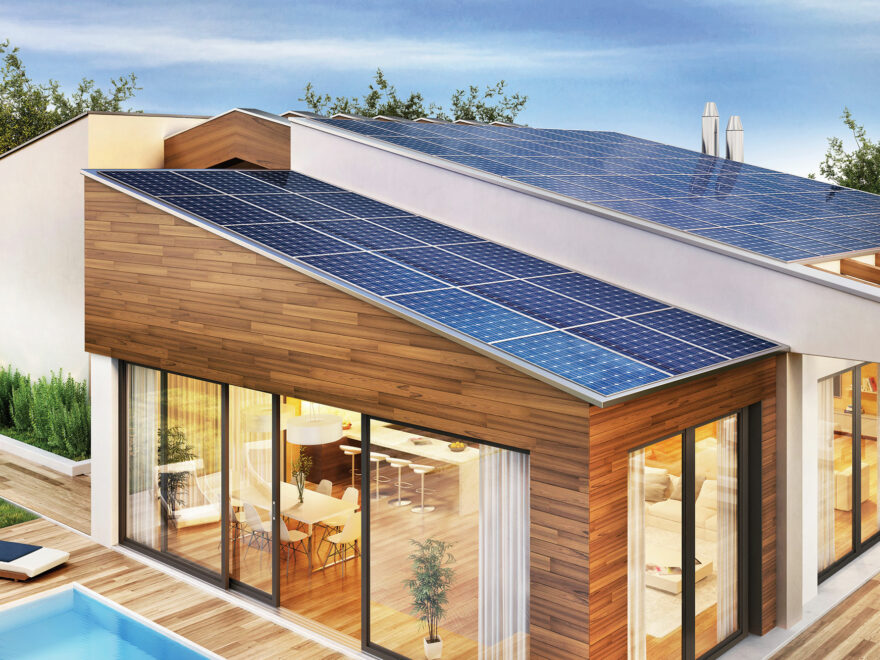From Smart to Smart and Sustainable
Since arriving in our homes, smart technology has put welcome conveniences at our fingertips.
Worried that you didn’t turn off the stove after leaving for a holiday weekend? Want to create your perfect movie-watching ambience without getting up from your sofa? Need to make sure your security system is alarmed? We can now monitor and adjust the status of the appliances and gadgets in our smart homes at any time, from anywhere, directly from our smartphones. However, with a growing demand for energy in our homes in recent years – and exacerbated by the COVID-19 pandemic – it is becoming increasingly clear that we need our living spaces to be not only smart but also sustainable. The fact is, sustainability today is a global priority. And everyone has a
role to play.
A recent study commissioned by Schneider Electric examines attitudes toward energy use and smart home technology across 3 countries in Europe and in the United States. The good news is, smart home technology is going mainstream, with consumers embracing the cost savings, energy efficiency, and home security that it delivers. However, homeowners are less aware that residential buildings will soon be the single largest source of the world’s carbon dioxide, responsible for up to 34% of
such emissions.
The study, which included 4,000 respondents from the United States, France, Germany and Sweden, revealed that consumers largely believe industrial facilities and transportation are responsible for carbon emissions; few cite residential buildings. And when it comes to reducing energy use, most people place responsibilities on business and government rather than themselves. Nevertheless, the majority of consumers believe it is important to reduce their carbon footprint and the amount of energy they use at home.
Active energy management is essential to making homes more sustainable. And while homeowners may embrace this practice primarily to reduce their energy consumption and cost, active energy management will also lessen their home’s carbon footprint and work toward making it a sustainable building. Demand, not supply, drives energy transitions. Our lives at home involve more electric gadgets and appliances than ever before, with electricity becoming consumers’ fuel of choice for cooking, lighting, and powering household electronics. A growing number of people are now charging electric vehicles at home, representing a significant new increase in home electricity use. At the same time, the cost of energy is rising. In response to this one-two punch to a homeowner’s wallet, the best defence is to practice active energy management. By combining smart devices with energy management software, homeowners can take control of their electricity consumption and achieve optimal efficiency.
A comprehensive home energy management system provides the ultimate payoff, delivering hyper-efficiency while advancing sustainability. In the near future, net zero homes will be possible as demand-side management solutions couple multiple energy sources, including onsite and microgrid supplies, with the loads of everything from appliances and EVs to HVAC systems. Smart solutions make life easier, increase safety and comfort, and add value to residential properties. According to the Schneider Electric study, 37% of consumers say that smart home technology makes a home or rental more desirable. The continuing pandemic is likely to reinforce this perception. In the new normal, the need to carve out places within the home that cater to the needs of each family member has gone from a nice-to-have to a must-have. Smart technology and digitization make it possible, giving us greater control over our home’s functionality while enabling us to create spaces that foster productivity, comfort, and well-being. Architects, home builders, and contractors are taking notice of consumer interest in smart home technology, and for good reason. According to the Schneider Electric study, 36% of consumers believe smart home products should be standard in newly built homes. In the future, residential living will be a more personalized experience, with smart technology enabling the home to interact with individual family members and provide actionable insights and advice for each of them. For example, your smart home system can tell you when to do your laundry or run your dishwasher based on your utility’s time-of-use electricity rates; help you plan your solar energy usage based on upcoming weather forecasts; automatically adjust lighting in different rooms at different times of day based on the season; and so much more.
In the post-Covid world, consumers will have more control over their home’s energy usage, making it easier to conserve resources and reduce the impact on environment and their home energy bills.
Net zero homes are growing in popularity because they produce as much energy as they consume, resulting in a zero energy bill and a carbon-neutral home. There is an ever-increasing array of tools and technologies that make net zero homes achievable, including:
- Solar panels
- Energy-efficient certified appliances
- Geothermal pumps
- Smart thermostats
- Weather-sealed doors and frames
- Radiant floor heating
An essential component of net zero homes is an energy management system. Wiser by Schneider Electric lets people monitor and control their energy use through smart technology. Wiser is a fully open system, able to interact with different platforms and devices, and allowing users to monitor their home’s connected and non-connected devices with a mobile app. Among its capabilities, the Wiser solution:
- Keeps tabs on a home’s electrical activity from anywhere via a phone or tablet
- Provides insights into energy use for greater savings
- Sends mobile alerts when appliances turn ON or OFF
- Works with ecosystems like Amazon Alexa®, Google Home™, and integrates with many leading interoperable smart home devices
Wiser also lets homeowners set energy usage goals, estimate monthly energy bills, and take  proactive action to cut energy waste. If your home is solar-equipped, you can view solar generation, take advantage of cheaper, off-peak energy, and monitor the return on your solar investment. Safety concerns? The system detects electrical use and sends notifications via the app, like when your garage door opens or if you forgot to turn off your curling iron.
proactive action to cut energy waste. If your home is solar-equipped, you can view solar generation, take advantage of cheaper, off-peak energy, and monitor the return on your solar investment. Safety concerns? The system detects electrical use and sends notifications via the app, like when your garage door opens or if you forgot to turn off your curling iron.
Conclusion: If the world is to meet ambitious goals for climate-neutrality by 2050, residential buildings must play an essential role. Currently they are responsible for up to 34% of carbon dioxide emissions. Solutions are available now to put homes on the path to net zero emissions, including Wiser by Schneider Electric. Equipped with these proven tools, homes can become more sustainable, resilient, efficient, and personalized. Homeowners will be able to save money and energy while doing their part to save the planet.
To review the complete study or for more information, visit se.com/ww/en/work/campaign/homes-of-the-future.
Edited from White Paper Smart Home_Survey-HD 998-21551003

